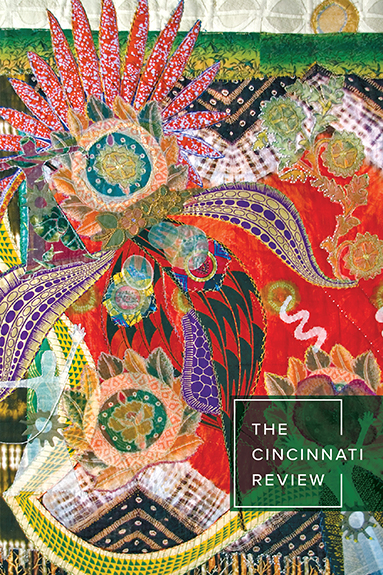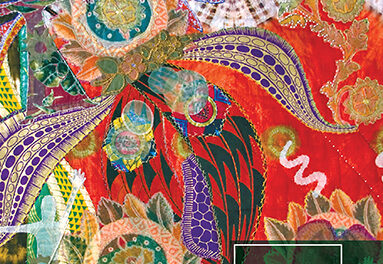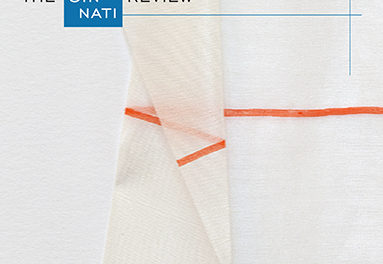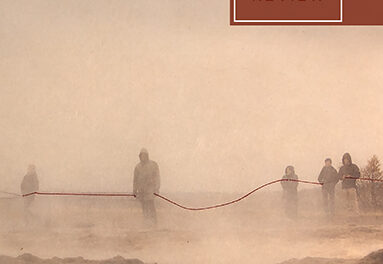In Issue 20.1, we present a craft review feature celebrating the art of extraordinary writing. The feature was inspired by Holly Goddard Jones’s “Unreasonably Good Stories: Breaking the Competency Ceiling,” and we’re pleased to share here Jay Franklin’s contribution to the conversation. (Read the entire feature here.)
Fleabag. Phoebe Waller-Bridge, creator. First aired in the US on 16 September 2016 and 17 May 2019. Amazon Prime Video.
Every serious relationship I’ve been in has forced me to confront myself. In my teens I learned about the need for boundaries. In my twenties the lesson was: just because I feel strongly about someone does not make them the partner for me. In my thirties, the lesson has been to embrace my vulnerability. Our culture is obsessed with love, yet there is rarely an honest depiction of the experience in our entertainment. The emphasis is often placed on the excitement of falling in love while glossing over a truth: each significant romantic relationship will challenge us to grow as an individual, as a partner, or both.
While meet-cutes and drama make for emotionally compelling television, what craft decisions can screenwriters and directors make if we want to dramatize the psychological nuances of love and offer the public more substantial examinations of its power? One way to do so is by taking a well-worn genre convention and recontextualizing it in a way that reveals character. I can’t think of a more elegant example than Phoebe Waller-Bridge’s use of the fourth wall in her series Fleabag.
Phoebe Waller-Bridge’s Fleabag has been acclaimed for countless reasons: its dark humor, ruthless editing, and unforgettable performances from Waller-Bridge and Sian Clifford, who plays Fleabag’s sister, Claire. What I love most about the series, and its second season in particular, is that it is wonderfully instructive for those of us writing about and—if I’m being honest—personally navigating the more painful and difficult aspects of romantic love, especially confronting oneself through intimacy.
In the first season of Fleabag, Waller-Bridge literalizes a complex coping mechanism through the complication of the fourth wall. From the first scene, Fleabag addresses the audience as if we were her best friend. As the show progresses, we learn that Boo—her actual best friend—took her own life after Fleabag had an affair with Boo’s boyfriend, and it becomes clear that Fleabag started directly addressing “us,” the audience, to cope with the pain of being a contributing factor in her friend’s death. There have been great characters in movie and television history who have broken the fourth wall (shout out to Zack Morris, Ferris Bueller, and Rue from Euphoria), and doing so inherently disarms the viewer because we are exposed to the character’s point of view in a way no one else in the story gets to experience. Combined with Fleabag’s wry sense of humor, this exposure ingratiates us to her and her bad behavior. But what makes Waller-Bridge’s use of it exceptional, so “unreasonably good,” is the intentional connection between the conceit and the character’s development: the fourth-wall break stems from the traumatic loss of her friend. Boo’s death establishes the audience as an emotional crutch, the only access Fleabag has to emotional intimacy.
To complicate the audience’s role for Fleabag, Waller-Bridge introduces an alternative source for intimacy in the second season, a love affair between Fleabag and her godmother’s “cool, sweary” Irish priest (played by the sparkly eyed Andrew Scott). In talking about his vocation in the first episode, Hot Priest (the only name he is given) explains to Fleabag’s family over dinner that “I came quite late to it actually. But it’s been a good life to me. I’ve really found peace in it.” And his search for peace is quickly justified: At the same dinner, he mentions that his parents were alcoholics—a bit of trivia he uses to relate to Fleabag’s brother-in-law, Martin—and that his brother is a pedophile. (“I’m aware of the irony,” he says, to break the tension).
Throughout the season, it’s also clear that his attraction to Fleabag disrupts his hard-won peace. “Peace be with you,” she repeats at the beginning of the second episode, smiling and greeting other parishioners, but her presence at Mass has the opposite impact on him. When he spots her from the lectern, he grins boyishly, looks down at the floor, thoroughly embarrassed, and struggles to find his words. After the service, he spills the tea he offers her then immediately suggests they drink gin. Midway through the season, Fleabag finds him in the vestry bumping early aughts hip-hop after hours, trying to reach a bottle of whiskey while an almost-empty bottle sits on the table. He is loose and, to Fleabag’s delight, letting sexual comments fly, for example, “Don’t call me ‘Father’ like it doesn’t turn you on just to say it.” He pours them both a glass and raises it in a toast. “Here’s to peace,” he says, “and those that get in the way of it.” He lets Fleabag get in the way of his vow of celibacy that night.
A break in the fourth wall is not especially radical—some may even call it a gimmick—but Waller-Bridge uses these well-worn, “gimmicky” conventions to pull the audience into ideas and depictions of love that are much more profound, even instructional. To position love as a kind of inquisition, a form of facing oneself, the first line of the second season is a question: while Fleabag stands before an elegant mirror, cleaning her bloodied nose and chin as inoffensive jazz music plays over the speaker, a voice from behind the bathroom door asks, “Can I do anything?” Chronologically, the moment takes place near the end of the episode, but it’s been edited to be the audience’s introduction to the couple—the voice, we will learn, belongs to the Hot Priest. In place of the meet-cute is a raw image of Fleabag’s pain, answered by a simple expression of curiosity and empathy, at once caring and a bit intrusive. Fleabag assures the voice she’s all right, hands a paper towel to another bloody-nosed woman sitting on the floor, then breaks the fourth wall to wryly inform the audience: “This is a love story.”
When we go back in time—though only about an hour—to meet the Priest for the first time, we’re thrown into a painfully awkward and increasingly chaotic family dinner. The two are seated next to each other, but she’s confused by his presence. “No idea who this guy is,” she tells the audience, roping us back in with irreverent wit and the warmth of being in her confidence. Her family mostly ignores her, and as she turns to the camera to complain, the Priest severs her bond with us:
Fleabag: No one’s asked me a question in forty-five min—
Priest: So what do you do?
In that instant, the entire focus of the scene turns to Fleabag, a cinematic shift dramatized by the show’s ruthlessly precise editing. The table goes quiet, and four quick cuts show everyone turning to Fleabag: first the Priest, then her father and godmother, then her sister and brother-in-law; and then, finally, we hold on a shot of the Priest and Fleabag looking into each other’s eyes. The moment breathes, and the look they share is given room to imprint on us, the audience, who have just been ejected from Fleabag’s confidence. It’s an excellent moment because it highlights her pain—how she feels disregarded and undervalued in her family—now attended to by the Priest’s curiosity, which temporarily forces the entire family to concentrate on her.
Here, Waller-Bridge reveals she is playing the long game with a convention, drawing the audience’s attention away from the external drama and actively dramatizing the qualities of the partnership that speak to its depth: Hot Priest is so attentive to Fleabag that it threatens the show’s most prominent stunt, positioning love as an uncomfortable face-off with one’s personality and coping mechanisms. As Fleabag and the Priest bond, she begins looking at the camera with an adorable, uncharacteristic shyness. As he asks more personal questions, her coy looks turn panicked and pleading, as if she expects us to break through the fourth wall in return and save her. By the fourth episode, in a stunning performance of avoidance, Fleabag oscillates between confiding in him and confiding in the audience. Having just revealed that she no longer runs the guinea-pig-themed cafe with her friend, she can’t bring herself to tell him that it’s because Boo committed suicide, let alone the role Fleabag played in Boo’s misery. Instead, she laughs nervously, glancing at the camera for help. The priest notices.
The Priest: That thing that you’re doing. It’s like you disappear.
Fleabag: What?
The Priest: What are you not telling me?
Fleabag: Nothing!
The Priest: Tell me what’s going on underneath there!
Fleabag: Nothing!
Fleabag: [to the camera] Nothing!
When she addresses the audience to insist that there’s “nothing” she’s keeping from him, knowing full well that we know exactly what she’s hiding, the Priest turns to the camera and screams right into the lens. It’s a playful scream, the kind one might use when playing hide-and-seek with a small child, but it’s a chilling moment. The Priest has fully inserted himself between Fleabag and her audience. They are playing a kind of cat and mouse—or hide-and-seek—a game they continue later in the episode, inside the confessional. The wall between Fleabag and the Priest creates enough of a hiding space for Fleabag to open up and tell him her deepest fears, a dynamic that simultaneously (and controversially) heightens the sexual tension between them.
The couple consummates their love, but they don’t get a happily-ever-after. He chooses to stay in the priesthood, recommitting himself to God instead of making a new commitment to her. In a remarkable act of vulnerability, Fleabag accepts his decision and still tells him, for the first time, that she loves him. “It’ll pass,” he says at first, but admits he loves her too before walking away from the bus station. Able to shoulder this heartbreak on her own, she endures the scene without breaking the fourth wall, and the relationship she’s built with us over two seasons comes to an end. Her bus is canceled; she begins the long walk home in the dark. As the camera begins to follow her, she looks over her shoulder and shakes her head “no.” In the distance, she waves goodbye. The conclusion of our relationship with Fleabag is given as much narrative weight as the conclusion of theirs, prioritizing not a happily-ever-after but Fleabag’s growth as a result of opening herself up to love, even if it ends in her rejection.
Relationships help us see ourselves clearly. They put our ways of communicating, our habits, and belief systems, to the test. When depicting a romantic love onscreen, it matters less if the couple stays together or breaks apart. What matters is how we push genre conventions like breaking the fourth wall to honestly depict our characters’ shortcomings in that relationship. As in Fleabag, these shortcomings can give them the opportunity to make necessary changes. It’s one of the hardest truths of love, but it still gives me hope.
Jay Franklin, a graduate of Hampton University and New York University’s MFA film program, is currently a staff writer on Netflix’s adaptation of Neil Gaiman’s comic book The Sandman. He has previously been honored as an Emmy award–winner for his work as an associate producer on The Daily Show with Jon Stewart.











